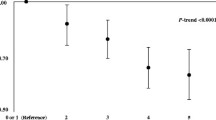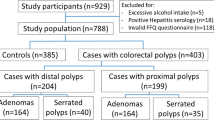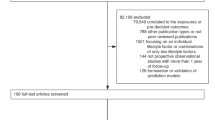Abstract
Background
Many modifiable lifestyle factors have been associated with colon cancer risk, but less is known about their effect on disease when considered together. Estimating the proportion of colon cancer cases that could be prevented by the adoption of combined modifiable lifestyle behaviors will provide important insights into disease prevention.
Methods
In the Nurses’ Health Study, we defined a low-risk group according to a combination of six factors: body mass index <25 kg/m2, physical activity of ≥21 metabolic equivalent of task per week, alcohol consumption ≤30 g/day, cigarette smoking <10 pack-years before the age of 30, current use of multivitamins for ≥15 years, and total calcium intake ≥700 mg/day. A composite risk score index was created and the population attributable risk (PAR%) was calculated after accounting for other known risk or protective factors.
Results
We documented 1,127 colon cancer cases among 81,092 over 24 years of follow-up. Compared with women in the lowest risk category, the women at all other exposure levels had a hazard ratio of colon cancer of 1.81 (95 % confidence interval 1.15–2.85). The score index was significantly and linearly related to an increasing risk of colon cancer (p value for trend <0.0001). The PAR% of the six risk factors considered together in relation to colon cancer was 0.37 (95 % CI 0.09–0.60). When regular aspirin use (two tablets/week for six or more years) was included with the other low-risk behaviors, the PAR% increased to 0.43 (95 % CI 0.14–0.65).
Conclusions
Beyond the known benefit from colonoscopy/sigmoidoscopy, key behavior modifications and adherence to a healthy lifestyle could avoid approximately 37 % of colon cancer cases among women.
Similar content being viewed by others
References
Siegel R, Naishadham D, Jemal A (2013) Cancer statistics, 2013. CA Cancer J Clin 63:11–30
Howlader N, Noone AM, Krapcho M, Neyman N, Aminou R, Altekruse SF, Kosary CL, Ruhl J, Tatalovich Z, Cho H, Mariotto A, Eisner MP, Lewis DR, Chen HS, Feuer EJ, Cronin KA (eds) (2011) SEER Cancer Statistics Review, 1975–2009 (Vintage 2009 Populations)
Huxley RR, Ansary-Moghaddam A, Clifton P, Czernichow S, Parr CL, Woodward M (2009) The impact of dietary and lifestyle risk factors on risk of colorectal cancer: a quantitative overview of the epidemiological evidence. Int J Cancer 125:171–180
Botteri E, Iodice S, Bagnardi V, Raimondi S, Lowenfels AB, Maisonneuve P (2008) Smoking and colorectal cancer: a meta-analysis. JAMA 300:2765–2778
Samad AK, Taylor RS, Marshall T, Chapman MA (2005) A meta-analysis of the association of physical activity with reduced risk of colorectal cancer. Colorectal Dis 7:204–213
Wolin KY, Yan Y, Colditz GA, Lee IM (2009) Physical activity and colon cancer prevention: a meta-analysis. Br J Cancer 100:611–616
Platz EA, Willett WC, Colditz GA, Rimm EB, Spiegelman D, Giovannucci E (2000) Proportion of colon cancer risk that might be preventable in a cohort of middle-aged US men. Cancer Causes Control 11:579–588
Wei EK, Colditz GA, Giovannucci EL, Fuchs CS, Rosner BA (2009) Cumulative risk of colon cancer up to age 70 years by risk factor status using data from the Nurses’ Health Study. Am J Epidemiol 170:863–872
Chan AT, Manson JE, Feskanich D, Stampfer MJ, Colditz GA, Fuchs CS (2007) Long-term aspirin use and mortality in women. Arch Intern Med 167:562–572
Giovannucci E, Egan KM, Hunter DJ et al (1995) Aspirin and the risk of colorectal cancer in women. N Engl J Med 333:609–614
Chan AT, Arber N, Burn J et al (2012) Aspirin in the chemoprevention of colorectal neoplasia: an overview. Cancer Prev Res (Phila) 5:164–178
Flossmann E, Rothwell PM, British Doctors Aspirin Trial and the UK-TIA Aspirin Trial (2007) Effect of aspirin on long-term risk of colorectal cancer: consistent evidence from randomised and observational studies. Lancet 369:1603–1613
Rothwell PM, Wilson M, Elwin CE et al (2010) Long-term effect of aspirin on colorectal cancer incidence and mortality: 20-year follow-up of five randomised trials. Lancet 376:1741–1750
Willett WC (1998) Nutritional epidemiology. Oxford University Press, Oxford
Colditz GA, Manson JE, Hankinson SE (1997) The Nurses’ Health Study: 20-year contribution to the understanding of health among women. J Womens Health 6:49–62
Willett WC, Sampson L, Stampfer MJ et al (1985) Reproducibility and validity of a semiquantitative food frequency questionnaire. Am J Epidemiol 122:51–65
Wu K, Willett WC, Chan JM et al (2002) A prospective study on supplemental vitamin e intake and risk of colon cancer in women and men. Cancer Epidemiol Biomark Prev 11:1298–1304
Chiuve SE, Giovannucci EL, Hankinson SE et al (2005) Alcohol intake and methylenetetrahydrofolate reductase polymorphism modify the relation of folate intake to plasma homocysteine. Am J Clin Nutr 82:155–162
Wolf AM, Hunter DJ, Colditz GA et al (1994) Reproducibility and validity of a self-administered physical activity questionnaire. Int J Epidemiol 23:991–999
Liang PS, Chen TY, Giovannucci E (2009) Cigarette smoking and colorectal cancer incidence and mortality: systematic review and meta-analysis. Int J Cancer 124:2406–2415
Renehan AG, Soerjomataram I, Tyson M et al (2010) Incident cancer burden attributable to excess body mass index in 30 European countries. Int J Cancer 126:692–702
Terry PD, Miller AB, Rohan TE (2002) Obesity and colorectal cancer risk in women. Gut 51:191–194
Colditz GA, Cannuscio CC, Frazier AL (1997) Physical activity and reduced risk of colon cancer: implications for prevention. Cancer Causes Control 8:649–667
Cho E, Smith-Warner SA, Ritz J et al (2004) Alcohol intake and colorectal cancer: a pooled analysis of 8 cohort studies. Ann Intern Med 140:603–613
Wei EK, Giovannucci E, Wu K et al (2004) Comparison of risk factors for colon and rectal cancer. Int J Cancer 108:433–442
Johnson IT, Lund EK (2007) Review article: nutrition, obesity and colorectal cancer. Aliment Pharmacol Ther 26:161–181
Giovannucci E, Stampfer MJ, Colditz GA et al (1998) Multivitamin use, folate, and colon cancer in women in the Nurses’ Health Study. Ann Intern Med 129:517–524
Puckett CD (1986) The Educational Annotation of ICD-9-CM, vol 1
Cox DR (1972) Regression models and life-tables. Anon J R Stat Soc 34:187–220
Fuchs CS, Giovannucci EL, Colditz GA, Hunter DJ, Speizer FE, Willett WC (1994) A prospective study of family history and the risk of colorectal cancer. N Engl J Med 331:1669–1674
Grodstein F, Newcomb PA, Stampfer MJ (1999) Postmenopausal hormone therapy and the risk of colorectal cancer: a review and meta-analysis. Am J Med 106:574–582
Fernandez E, La Vecchia C, Franceschi S et al (1998) Oral contraceptive use and risk of colorectal cancer. Epidemiology 9:295–300
Fernandez E, Gallus S, Bosetti C, Franceschi S, Negri E, La Vecchia C (2003) Hormone replacement therapy and cancer risk: a systematic analysis from a network of case–control studies. Int J Cancer 105:408–412
Chute CG, Willett WC, Colditz GA, Stampfer MJ, Rosner B, Speizer FE (1991) A prospective study of reproductive history and exogenous estrogens on the risk of colorectal cancer in women. Epidemiology 2:201–207
Chan AT, Giovannucci EL, Meyerhardt JA, Schernhammer ES, Wu K, Fuchs CS (2008) Aspirin dose and duration of use and risk of colorectal cancer in men. Gastroenterology 134:21–28
Zhang X, Giovannucci EL, Wu K et al (2013) Associations of self-reported sleep duration and snoring with colorectal cancer risk in men and women. Sleep 36:681–688
Bruzzi P, Green SB, Byar DP, Brinton LA, Schairer C (1985) Estimating the population attributable risk for multiple risk factors using case–control data. Am J Epidemiol 122:904–914
Wacholder S, Benichou J, Heineman EF, Hartge P, Hoover RN (1994) Attributable risk: advantages of a broad definition of exposure. Am J Epidemiol 140:303–309
Rothman K, Greenland S (1998) Modern epidemiology. Lippincott-Raven, Philadelphia
Park Y, Spiegelman D, Hunter DJ et al (2010) Intakes of vitamins A, C, and E and use of multiple vitamin supplements and risk of colon cancer: a pooled analysis of prospective cohort studies. Cancer Causes Control 21:1745–1757
Lee JE, Willett WC, Fuchs CS et al (2011) Folate intake and risk of colorectal cancer and adenoma: modification by time. Am J Clin Nutr 93:817–825
Giovannucci E (2002) Epidemiologic studies of folate and colorectal neoplasia: a review. J Nutr 132:2350S–2355S
Zhang X, Giovannucci EL, Wu K et al (2012) Magnesium intake, plasma C-peptide, and colorectal cancer incidence in US women: a 28-year follow-up study. Br J Cancer 106:1335–1341
Martinez ME, Giovannucci EL, Colditz GA et al (1996) Calcium, vitamin D, and the occurrence of colorectal cancer among women. J Natl Cancer Inst 88:1375–1382
Willett WC (1994) Micronutrients and cancer risk. Am J Clin Nutr 59:1162S–1165S
Hubner RA, Houlston RS (2009) Folate and colorectal cancer prevention. Br J Cancer 100:233–239
Du W, Li WY, Lu R, Fang JY (2010) Folate and fiber in the prevention of colorectal cancer: between shadows and the light. World J Gastroenterol 16:921–926
Kim YS, Milner JA (2007) Dietary modulation of colon cancer risk. J Nutr 137:2576S–2579S
Stone WL, Papas AM (1997) Tocopherols and the etiology of colon cancer. J Natl Cancer Inst 89:1006–1014
Feskanich D, Ma J, Fuchs CS et al (2004) Plasma vitamin D metabolites and risk of colorectal cancer in women. Cancer Epidemiol Biomark Prev 13:1502–1508
Ruder EH, Thiebaut AC, Thompson FE et al (2011) Adolescent and mid-life diet: risk of colorectal cancer in the NIH-AARP Diet and Health Study. Am J Clin Nutr 94:1607–1619
Gaziano JM, Sesso HD, Christen WG et al (2012) Multivitamins in the prevention of cancer in men: the Physicians’ Health Study II randomized controlled trial. JAMA 308:1871–1880
Wu K, Willett WC, Fuchs CS, Colditz GA, Giovannucci EL (2002) Calcium intake and risk of colon cancer in women and men. J Natl Cancer Inst 94:437–446
Larsson SC, Bergkvist L, Rutegard J, Giovannucci E, Wolk A (2006) Calcium and dairy food intakes are inversely associated with colorectal cancer risk in the Cohort of Swedish Men. Am J Clin Nutr 83:667–673 (quiz 728–729)
Kesse E, Boutron-Ruault MC, Norat T, Riboli E, Clavel-Chapelon F, E3N Group (2005) Dietary calcium, phosphorus, vitamin D, dairy products and the risk of colorectal adenoma and cancer among French women of the E3N-EPIC prospective study. Int J Cancer 117:137–144
Flood A, Peters U, Chatterjee N, Lacey JV Jr, Schairer C, Schatzkin A (2005) Calcium from diet and supplements is associated with reduced risk of colorectal cancer in a prospective cohort of women. Cancer Epidemiol Biomark Prev 14:126–132
National Center for Chronic Disease Prevention and Health Promotion, President’s Council on Physical Fitness and Sports (1996) Physical activity and health: a report of the Surgeon General
Pate RR, Pratt M, Blair SN et al (1995) Physical activity and public health. A recommendation from the Centers for Disease Control and Prevention and the American College of Sports Medicine. JAMA 273:402–407
Hu FB, Manson JE, Stampfer MJ et al (2001) Diet, lifestyle, and the risk of type 2 diabetes mellitus in women. N Engl J Med 345:790–797
Stampfer MJ, Hu FB, Manson JE, Rimm EB, Willett WC (2000) Primary prevention of coronary heart disease in women through diet and lifestyle. N Engl J Med 343:16–22
La Vecchia C, Braga C, Franceschi S, Dal Maso L, Negri E (1999) Population-attributable risk for colon cancer in Italy. Nutr Cancer 33:196–200
Martinez ME, Giovannucci E, Spiegelman D, Hunter DJ, Willett WC, Colditz GA (1997) Leisure-time physical activity, body size, and colon cancer in women. Nurses’ Health Study Research Group. J Natl Cancer Inst 89:948–955
Kirkegaard H, Johnsen NF, Christensen J, Frederiksen K, Overvad K, Tjonneland A (2010) Association of adherence to lifestyle recommendations and risk of colorectal cancer: a prospective Danish cohort study. BMJ 341:c5504
Loprinzi PD, Cardinal BJ (2012) Interrelationships among physical activity, depression, homocysteine, and metabolic syndrome with special considerations by sex. Prev Med 54:388–392
Liangpunsakul S (2010) Relationship between alcohol intake and dietary pattern: findings from NHANES III. World J Gastroenterol 16:4055–4060
Acknowledgments
We would like to thank the participants and staff of the Nurses’ Health Study for their valuable contributions as well as the following state cancer registries for their help: AL, AZ, AR, CA, CO, CT, DE, FL, GA, ID, IL, IN, IA, KY, LA, ME, MD, MA, MI, NE, NH, NJ, NY, NC, ND, OH, OK, OR, PA, RI, SC, TN, TX, VA, WA, and WY. This work was supported by the National Institutes of Health (NIH) grants UM1CA167552 (to W. C. Willett), P01CA87969 (to E. L. Giovannucci), U01CA186107 (to M.J. Stampfer), R03CA176717 (to X Zhang), and R25CA057711 (to, G. C. Sorensen). The content is solely the responsibility of the authors and does not necessarily represent the official views of the NIH.
Conflict of interest
None.
Author information
Authors and Affiliations
Corresponding authors
Additional information
Jennifer Erdrich and Xuehong Zhang have contributed equally to this work.
Electronic supplementary material
Below is the link to the electronic supplementary material.
Rights and permissions
About this article
Cite this article
Erdrich, J., Zhang, X., Giovannucci, E. et al. Proportion of colon cancer attributable to lifestyle in a cohort of US women. Cancer Causes Control 26, 1271–1279 (2015). https://doi.org/10.1007/s10552-015-0619-z
Received:
Accepted:
Published:
Issue Date:
DOI: https://doi.org/10.1007/s10552-015-0619-z




